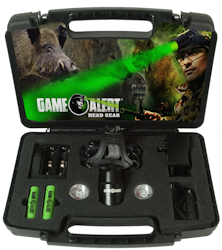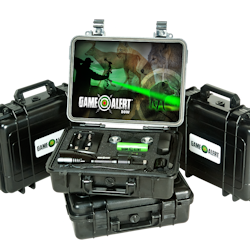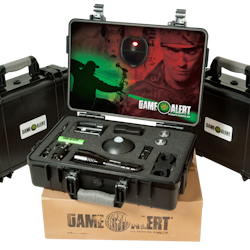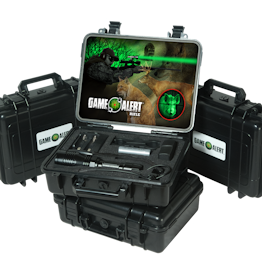So, Where Do I Aim For The Quickest Kill?
It is important to understand a few things about the wild hog’s anatomy in order to consistently kill him, regardless of the weapon. Through the years, I’ve lost more hogs from shots that were too far behind the shoulder or too high into the shoulders than any other shot placement. Hogs carry their vitals a bit farther forward and lower in the chest cavity than deer. A hog’s heart is very low in his chest.
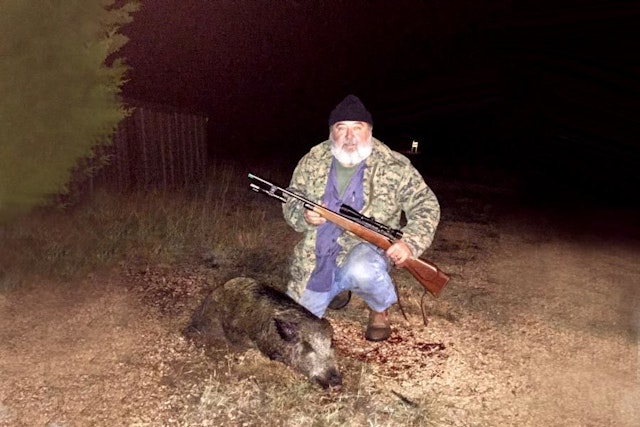
A good rule of thumb, when determining the exact location of a hog’s vitals is to draw an imaginary vertical line from the hog’s front feet up to the top of his back. To center the hog’s vitals, estimate a third of the way up, from the hog’s belly line and place your sight pin or crosshairs. You have read and heard a lot about the protective shield of hardened fat and gristle that cover the hog’s front shoulders/vitals. On a big boar, even the hardest shooting bow with the best broad-head on the market will not penetrate this layer that is as tough as rawhide but any well designed center fire bullet, from anything from a 30/30 caliber up will punch right thought at least one side of the hog and drive the bullet into the vitals form a magnum caliber.
We must consider what we are using to shoot the hog with in order to determine proper bullet/broad-head placement. Let’s consider killing hogs with a broad-head first. A through-the-shoulder shot with any bow, regardless if it’s a compound or crossbow, is not advisable for taking larger boars. Hogs up to 125-pounds or so can be drilled through the shoulders with bows pulling 60-pounds or more with good results, assuming the shot placement is in the lower one third of the hog’s body or in the spine. The spine is relatively straight for much of the hog’s body but the closer to the head it gets, the more curvature. Hitting the spine above the heart/lungs region is iffy at best and usually occurs when a shot is a little high. I’ve lost several hogs through the years by shooting too high into that “safety zone” above the lungs. A hog’s spine is straight for much of the hog’s body but the closer to the head it gets, the more curvature. Hitting the spine above the heart/lungs region is iffy at best and usually occurs when a shot is a little high. I’ve lost several hogs through the years by shooting too high into that “safety zone” above the lungs.
On larger boars, with a shoulder shot the broad head will invariably make contact with either the protective shield or the shoulder bone which is shaped like a ‘Y’ and very tough to penetrate, or both. On several occasions, I have killed boars that, during the skinning/ butchering process, I discovered broad-heads lodged just under the skin in the shoulder. I and many other bow hunters have taken many old, tough boars with archery equipment. The key is to first understand the precise location of the heart/lungs and then place the arrow so that it will be driven into this lethal killing zone. A slightly quartering away shot is absolutely lethal, even on the biggest of boars but shot placement has to be precise. If the hog is not in perfect position, DON’T shoot! Take your time and wait until the boar extends the leg closest to you out and exposes the shooting “window” that will allow your quartering arrow to drive into the vitals. In truth, the vast majority of hogs taken are around baited areas. I’d estimate a good seventy five percent of the hogs I have killed with a bow through the years were busy crunching bait while I waited in my stand. A feeding hog is in no hurry and if given time, he will usually eventually give you that perfect quartering shot. We can’t be that picky sometimes when we’re stalking hogs with archery equipment. A perfect broadside shot on a standing hog is also a high percentage shot if your aim is in the lower chest cavity and in tight to the hog’s shoulder although I much prefer the hog to be slightly quartering away so I can slip the arrow in just behind the leg bone.
On larger boars, with a center of shoulder shot the broad-head will invariably make contact with either the protective shield or the shoulder bone which is shaped like a ‘Y’ and very tough to penetrate, or both. On several occasions, I have killed boars that, during the skinning/ butchering process, I discovered broad-heads lodged just under the skin in the shoulder. I and many other bow hunters have taken many old, tough boars with archery equipment. The key is to first understand the precise location of the heart/lungs and then place the arrow so that it will be driven into this lethal killing zone. A slightly quartering away shot is absolutely lethal, even on the biggest of boars but shot placement has to be precise. If the hog is not in perfect position, DON’T shoot! Take your time and wait until the boar extends the leg closest to you out and exposes the shooting “window” that will allow your quartering arrow to drive into the vitals. In truth, the vast majority of hogs taken are around baited areas. I’d estimate a good seventy five percent of the hogs I have killed with a bow through the years were busy crunching bait while I waited in my stand. A feeding hog is in no hurry and if given time, he will usually eventually give you that perfect quartering shot. We can’t be that picky sometimes when we’re stalking hogs with archery equipment. A perfect broadside shot on a standing hog is also a high percentage shot if your aim is in the lower chest cavity and in tight to the hog’s shoulder. Visualize the location of the leg bone by drawing an imaginary vertical line from the hog’s foot up and slide that arrow in just behind this line. This shot will center the heart/lungs and impact the hog just behind the leg bone.
The key thing to remember is that shots a little bit too far FORWARD often result in a dead hog while those that hit a bit too far back result in a long and difficult tracking job!


